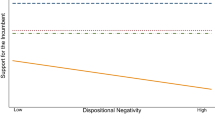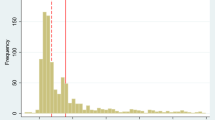Abstract
Participants in contingent valuation surveys and jurors setting punitive damages in civil trials provide answers denominated in dollars. These answers are better understood as expressions of attitudes than as indications of economic preferences. Well-established characteristics of attitudes and of the core process of affective valuation explain several robust features of dollar responses: high correlations with other measures of attractiveness or aversiveness, insensitivity to scope, preference reversals, and the high variability of dollar responses relative to other measures of the same attitude.
Similar content being viewed by others
References
Anderson, Norman. (1996). A Functional Theory of Cognition. Mahwah, NJ: Erlbaum.
Arrow, Kenneth. (1982). “Risk Perception in Psychology and Economics,” Economic Inquiry 20, 1–9.
Baron, Jonathan and Joshua Greene. (1996). “Determinants of Insensitivity to Quantity in Valuation of Public Goods: Contribution, Warm Glow, Budget Constraints, Availability, and Prominence,” Journal of Experimental Psychology: Applied 2, 107–125.
Barsalou, Lawrence. (1992). Cognitive Psychology: An Overview for Cognitive Scientists. NJ: Erlbaum.
Bartels, Larry M. (1998). “Democracy With Attitudes,” Paper presented at the annual meeting of American Political Science Association, Boston.
Carson, Richard, Michael Hanemann, Raymond Kopp, John Krosnick, Robert Mitchell, Stanley Presser, Paul Ruud, and V. Kerry Smith. (1994). Prospective Interim Lost Use Value Due to DDT and PCB Contamination in the Southern California Bight. La Jolla, CA: Natural Resource Damage Assessment.
Carson, Richard and Robert Mitchell. (1993). “The Issue of Scope in Contingent Valuation Studies,” American Journal of Agricultural Economics 75, 1263–1267.
Carson, Richard and Robert Mitchell. (1995). “Sequencing and Nesting in Contingent Valuation Surveys,” Journal of Environmental Economics and Management 28, 155–173.
Chapman, Gretchen, and Brian Bornstein. (1996). “The More You Ask for the More You Get: Anchoring in Personal Injury Verdicts,” Applied Cognitive Psychology 10, 519–540.
Cummings, Ronald, Glenn Harrison, and Elizabeth Rutstrom. (1995). “Homegrown Values and Hypothetical Surveys: Is the Dichotomous Choice Approach Incentive-Compatible?” American Economic Review 85, 260–266.
DeKay, Michael and Gary McClelland. (1996). “Probability and Utility Components of Endangered Species Preservation Programs,” Journal of Experimental Psychology: Applied 2, 60–83.
Desvousges, William, F. Reed Johnson, Richard Dunford, Kevin Boyle, Sarah Hudson, and K. Nicole Wilson. (1992). Measuring Non-Use Damages Using Contingent Valuation: An Experimental Evaluation of Accuracy. Research Triangle Institute Monograph 92–1.
Diamond, Peter. (1996). “Testing the Internal Consistency of Contingent Valuation Surveys.” Journal of Environmental Economics and Management 30, 337–347.
Diamond, Peter, John Hausman, Gregory Leonard, and Michael Denning. (1993). “Does Contingent Valuation Measure Preferences? Experimental Evidence.” In J. A. Hausman ed., Contingent Valuation: A Critical Assessment. Amsterdam: North-Holland.
Diamond, Peter and John Hausman. (1994). “Contingent Valuation: Is Some Number Better Than No Number?” Journal of Economic Perspectives 8, 45–64.
Eagly, Alice and Shelley Chaiken. (1993). The Psychology of Attitudes. Fort Worth, TX: Harcourt Brace.
Eagly, Alice and Shelley Chaiken. (1996). “Attitude Structure and Function.” In Gilbert, D., S. Fiske, and G. Lindzey eds., The Handbook of Social Psychology, 4th ed. New York: McGraw-Hill.
Fazio, Russell, David Sanbonmatsu, Martha Powell, and Frank Kardes. (1986). “On the Automatic Activation of Attitudes.” Journal of Personality and Social Psychology 50, 229–238.
Fischhoff, Baruch. (1991). “Value Elicitation: Is There Anything in There?” American Psychologist 46, 835–847.
Foster, Vivien, Ian J. Bateman, and David Harley. (1997). “Real and Hypothetical Willingness to Pay for Environmental Preservation: A Non-Experimental Comparison,” Journal of Agricultural Economics 48, 123–138.
Frederick, Shane and Baruch Fischhoff. (1998). “Scope In Sensitivity in Elicited Valuations,” Risk Decision and Policy 3, 109–123.
Green, Donald, Karen Jacowitz, Daniel Kahneman, and Daniel McFadden. (1998). “Referendum Contingent Valuation, Anchoring, and Willingness to Pay for Public Goods.” Resource and Energy Economics 20, 85–116.
Griffin, Dale and Amos Tversky. (1992). “The Weighing of Evidence and the Determinants of Confidence,” Cognitive Psychology 24, 411–435.
Hanemann, Michael. (1994). “Valuing the Environment Through Contingent Valuation,” Journal of Economic Perspectives 8, 19–43.
Hastie, Reid, David Schkade, and John Payne. (1999). “Juror Judgments in Civil Cases: Effects of Plaintiff's Request and Plaintiff's Identity on Punitive Damage Awards.” Law and Human Behavior 23, 445–470.
Hoehn, John and Alan Randall. (1987). “Too Many Proposals Pass the Benefit Cost Test,” American Economic Review 79, 544–551.
Hsee, Chris. (1996). “The Evaluability Principle: An Explanation for Preference Reversals between Joint and Separate Evaluations of Alternatives,” Organizational Behavior and Human Decision Processes 67, 247–257.
Jacowitz, Karen and Daniel Kahneman. (1995). “Measures of Anchoring in Estimation Tasks,” Personality and Social Psychology Bulletin 21, 1161–1166.
Jones-Lee, Michael, Graham Loomes, and P. Philips. (1995). “Valuing the Prevention of Non-Fatal Road Injuries: Contingent Valuation vs. Standard Gambles,” Oxford Economic Papers 47, 676–695.
Kahneman, Daniel. (1986). “Valuing Environmental Goods: An Assessment of the Contingent Valua-tion Method.” In R. Cummings, D. Brookshire, and W. Schulze eds. Valuing Environmental Goods: An Assessment of the Contingent Valuation Method. Totowa, NJ.
Kahneman, Daniel. (1995). “Extension Neglect and Violations of Monotonicity in Judgment and Preference: Three Examples,” Bartlett Lecture to the Experimental Psychology Society UK.
Kahneman, Daniel, Barbara Fredrickson, Charles Schreiber, and Don Redelmeier. (1993). “When More Pain Is Preferred to Less,” Psychological Science 4, 401–405.
Kahneman, Daniel and Jack Knetsch. (1992). “Valuing Public Goods: The Purchase of Moral Satisfaction,” Journal of Environmental Economics and Management 22, 57–70.
Kahneman, Daniel, Jack Knetsch, and Richard Thaler. (1991). “The Endowment Effect, Loss Aversion, and Status Quo Bias,” Journal of Economic Perspectives, 5, 193–206.
Kahneman, Daniel and Dale Miller. (1986). “Norm Theory: Comparing Reality to Its Alternatives,” Psychological Review 93, 136–153.
Kahneman, Daniel and Ilana Ritov. (1994). “Determinants of Stated Willingness to Pay for Public Goods: A Study in the Headline Method,” Journal of Risk and Uncertainty 9, 5–38.
Kahneman, Daniel, David Schkade, Elana Ritov and Cass Sunstein. (1999). “Reversals of judgement; The effect of cross-category comparisons intendedly absolute scales,” manuscript order review.
Kahneman, Daniel, David Schkade, and Cass Sunstein. (1998). “Shared Outrage and Erratic Awards: The Psychology of Punitive Damages,” Journal of Risk and Uncertainty 16, 49–86.
Kahneman, Daniel and Amos Tversky. (1972). “Subjective Probability: A Judgment of Representativeness.” Cognitive Psychology 3, 430–454.
Kahneman, Daniel and Amos Tversky. (1973). “On the Psychology of Prediction.” Psychological Review 80, 237–254.
Kahneman, Daniel and Amos Tversky. (1979). “Prospect Theory: An Analysis of Decision under Risk,” Econometrica 47, 263–291.
Kahneman, Daniel, Peter Wakker, and Rakesh Sarin. (1997). “Back to Bentham? Explorations of Experienced Utility,” Quarterly Journal of Economics 112, 375–405.
Kemp, Michael and Christopher Maxwell. (1993). “Exploring a Budget Context for Contingent Valua-tion.” In Hausman ed., Contingent Valuation: A Critical Assessment. Amsterdam: North-Holland.
Koehler, Jonathan. (1996). “The Base-Rate Fallacy Reconsidered: Descriptive, Normative, and Methodological Challenges.” Behavioral and Brain Sciences 19, 1–53.
Levav, Jonathan. (1996). “Questioning Contingent Valuation: Maximality and Violations of Monotonicity in Willingness-to-Pay for Public Goods,” Unpublished undergraduate thesis, Princeton University.
Lodge, Milton. (1981). “Magnitude Scaling: Quantitative Measurement of Opinions.” InJ. Sullivan ed., Quantitative Applications in the Social Sciences, Vol. 25. Beverly Hills, CA: Sage Publications.
Loomis, John, Armando Gonzalez-Caban, and Robin Gregory. (1994). “Do Reminders of Substitutes and Budget Constraints Influence Contingent Valuation Estimates?” Land Economics 70, 499–506.
McFadden, Daniel. (1994). “Contingent Valuation and Social Choice,” American Journal of Agricultural Economics 76, 689–708.
McFadden, Daniel. (1999). “Rationality for Economists,” Journal of Risk and Uncertainty 19, 73–106.
McFadden, Daniel and Gregory Leonard. (1993). “Issues in the Contingent Valuation of Environmental Goods: Methodologies for Data Collection and Analysis.” In Hausman ed., Contingent Valuation: A Critical Assessment. Amsterdam: North-Holland.
Mitchell, Robert and Richard Carson. (1989). Using Surveys to Value Public Goods. Washington, DC: Resources for the Future.
Neill, Helen. (1995). “The Context for Substitutes in CVM Studies: Some Empirical Observations,” Journal of Environmental Economics and Management 29, 393–397.
Nickerson, Carol. (1995). “Does Willingness-to-Pay Reflect the Purchase of Moral Satisfaction? A Reconsideration of Kahneman and Knetsch,” Journal of Environmental Economics and Management 28, 126–133.
NOAA panel report. U.S. Department of Commerce, National Oceanic and Atmospheric Administra-tion. (1993). “Natural Resource Damage Assessments under the Oil Pollution Act of 1990,” Federal Register 58, 4601–4614.
Novemsky, Nathan and Shirit Kronzon. (1999). “How Are Base-Rates Used, When They Are Used: A Comparison of Bayesian and Additive Models of Base-Rate Use,” Journal of Behavioral Decision Making 12, 55–69.
Osgood, Charles, George Suci, and Percy Tannenbaum. (1957). The Measurement of Meaning. Urbana: University of Illinois Press.
Payne, John, James Bettman, and Eric Johnson. (1992). “Behavioral Decision Research: A Constructive Processing Perspective.” Annual Review of Psychology 43, 87–131.
Payne, John W., James R. Bettman, and David A. Schkade. (1999). “Measuring Constructed Preferences: Towards a Building Code.” Journal of Risk and Uncertainty 19, 243–270.
Payne, John, David Schkade, William Desvousges, and Chris Aultman. (1999). “Valuation of Multiple Environmental Programs: A Psychological Analysis,” Unpublished manuscript, Duke University.
Pratto, F. (1994). “Consciousness and Automatic Evaluation.” In Paula M. Niedenthal and Shinobu Kitayama Eds., The Heart's Eye: Emotional Influences in Perception and Attention. Academic Press, Inc, San Diego, CA.
Quattrone, George and Amos Tversky. (1984). “Causal Versus Diagnostic Contingencies: On Self-Deception and the Voter's Illusion,” Journal of Personality and Social Psychology 46, 237–248.
Randall, Alan and John Hoehn. (1996). “Embedding in Market Demand Systems,” Journal of Environmental Economics and Management 30, 369–380.
Ritov, Ilana, Jonathan Baron, and John Hershey. (1993). “Framing Effects in the Evaluation of Multiple Risk Reduction,” Journal of Risk and Uncertainty 6, 145–159.
Ritov, Ilana. (1996). “Anchoring in a Simulated Competitive Market Negotiation,” Organizational Behavior and Human Decision Processes 67, 16–25.
Rosch, Eleanor and Barbara Lloyd. (1978). Cognition and Categorization. Hillsdale, NJ: Erlbaum.
Rottenstreich, Yuval and Amos Tversky. (1997). “Unpacking, Repacking, and Anchoring: Advances in Support Theory,” Psychological Review, 104, 406–415.
Rutherford, Murray, Jack Knetsch, and Thomas Brown. (1998). “Assessing Environmental Losses: Judgments of Importance and Damage Schedules,” Harvard Environmental Law Review, 22, 51–101.
Schreiber, Charles and Daniel Kahneman. (2000). “Beyond the Peak and End Hypothesis: Exploring the Relation between Real-Time Pleasure and Retrospective Evaluations,” Journal of Experimental Psychology.
Seip, Kalle and Jon Strand. (1992). “Willingness to Pay for Environmental Goods in Norway: A Contingent Valuation Study with Real Payment,” Environmental and Resource Economics 2, 91–106.
Slovic, Paul. (1995). “The Construction of Preference,” American Psychologist, 50, 364–371.
Smith, V. Kerry. (1992). “Arbitrary Values, Good Causes, and Premature Verdicts,” Journal of Environmental Economics and Management 22, 71–89.
Strack, Fritz and Thomas Mussweiler. (1997). “Explaining the Enigmatic Anchoring Effect: Mechanisms of Selective Accessibility,” Journal of Personality and Social Psychology 73, 437–446.
Stevens, Stanley S. (1975). Psychophysics. Introduction to Its Perceptual, Neural, and Social Prospects. Wiley: NY.
Sunstein, Cass, Daniel Kahneman, and David Schkade. (1998). “Assessing Punitive Damages,” Yale Law Journal 107, 2071–2153.
Tesser, Abraham and Leonard Martin. (1996). “The Psychology of Evaluation.” In E. T. Higgins, and A. Kruglanski eds., Social Psychology: Handbook of Basic Principles, pp. 400–432. New York: Guilford Press.
Thaler, Richard. (1992). The Winner's Curse: Paradoxes and Anomalies of Economic Life. New York: The Free Press.
Tversky, Amos and Daniel Kahneman. (1971). “Belief in the Law of Small Numbers,” Psychological Bulletin 76, 105–110.
Tversky, Amos and Daniel Kahneman. (1982). “Evidential Impact of Base Rates.” In D. Kahneman, P. Slovic, and A. Tversky eds., Judgment under Uncertainty: Heuristics and Biases. New York: Cambridge University Press.
Tversky, Amos and Daniel Kahneman. (1983). “Extensional vs. Intuitive Reasoning: The Conjunction Fallacy in Probability Judgment,” Psychological Review 90, 293–3l5.
Tversky, Amos and Daniel Kahneman. (1986). “Rational Choice and the Framing of Decisions,” Journal of Business 59, 251–278.
Tversky, Amos and Richard Thaler. (1992). “Preference Reversals.” In R. H. Thaler ed., The Winner's Curse: Paradoxes of Economic Life. New York: The Free Press.
Varey, Carol and Daniel Kahneman. (1992). “Experiences Extended Across Time: Evaluation of Moments and Episodes,” Journal of Behavioral Decision Making 5, 169–185.
Varian, Hal. (1984). Microeconomic Analysis. New York: Norton.
Wilson, Thomas, Christopher Houston, Kathryn Etling, and Nancy Brekke. (1996). “A New Look at Anchoring Effects: Basic Anchoring and Its Antecedents,” Journal of Experimental Psychology: General 125, 387–402.
Zaller, John. (1992). The Nature and Origins of Mass Opinion. Cambridge, UK: Cambridge University Press.
Author information
Authors and Affiliations
Rights and permissions
About this article
Cite this article
Kahneman, D., Ritov, I. & Schkade, D. Economic Preferences or Attitude Expressions?: An Analysis of Dollar Responses to Public Issues. Journal of Risk and Uncertainty 19, 203–235 (1999). https://doi.org/10.1023/A:1007835629236
Issue Date:
DOI: https://doi.org/10.1023/A:1007835629236




